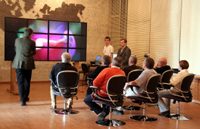SAGE-enabled Cyberspace Demonstration over GLORIAD Takes Place as Part of Sputnik Celebration
October 3rd, 2007
Categories: Applications, Networking, Visualization

About
MOSCOW, CHICAGO and AMSTERDAM - Fifty years ago, the Soviet Union launched Sputnik I - little more than a beeping metal ball - into space. Never before had an artificial satellite orbited the Earth.
Sputnik I advanced the future of space travel, and this week, its historically significant launch was marked with a global networking demonstration that advances the future of cyber travel.
At Russia’s International Forum for the 50th anniversary of Sputnik I, a five-day celebration of the historic launch being held in Moscow and St. Petersburg, guests attending a special demonstration at the Russian Academy of Sciences (RAS) Space Research Institute (IKI) in Moscow saw high-resolution animations streamed from the United States and the Netherlands to Russia over GLORIAD research and education networks using visualization middleware called the Scalable Adaptive Graphics Environment (SAGE).
For this demonstration, scientific visualizations were streamed from data stores in Chicago and Amsterdam to a tiled display wall at the IKI.
Animations of the Milky Way galaxy and a tornado, both developed by the University of Illinois’ National Center for Supercomputing Applications (NCSA), were streamed at one gigabit-per-second to Moscow’s IKI from disks at the University of Illinois at Chicago’s (UIC) Electronic Visualization Laboratory (EVL) in Chicago, and from the SARA Computing and Networking Services supercomputer center in Amsterdam.
This demonstration was organized by the Russia-USA GLORIAD team and by the Global Lambda Visualization Facility (GLVF), an international team of computer and application scientists, founded by EVL, which strives to create integrated tools for domain scientists, enabling them to conduct real-time, interactive visualization and distance collaboration using large-scale tiled displays over optical networks.
EVL’s SAGE is used as a tool for managing multiple high-resolution data streams over these networks. And, these advanced optical networks are cooperatively shared for scientific experimentation through an organization called the Global Lambda Integrated Facility, or GLIF.
Read the complete article at:
www.gloriad.org/gloriad/news/pr-us-russia-sage.html